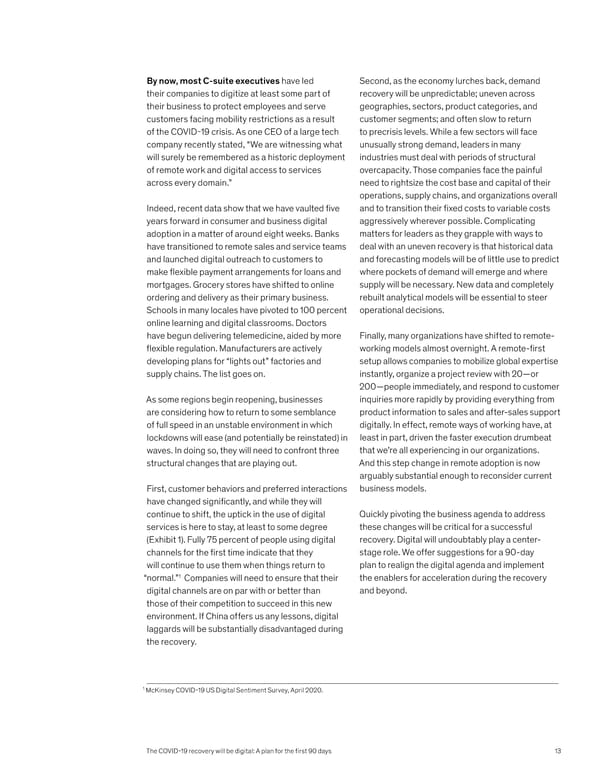By now, most C-suite executives have led Second, as the economy lurches back, demand their companies to digitize at least some part of recovery will be unpredictable; uneven across their business to protect employees and serve geographies, sectors, product categories, and customers facing mobility restrictions as a result customer segments; and often slow to return of the COVID-19 crisis. As one CEO of a large tech to precrisis levels. While a few sectors will face company recently stated, “We are witnessing what unusually strong demand, leaders in many will surely be remembered as a historic deployment industries must deal with periods of structural of remote work and digital access to services overcapacity. Those companies face the painful across every domain.” need to rightsize the cost base and capital of their operations, supply chains, and organizations overall Indeed, recent data show that we have vaulted five and to transition their fixed costs to variable costs years forward in consumer and business digital aggressively wherever possible. Complicating adoption in a matter of around eight weeks. Banks matters for leaders as they grapple with ways to have transitioned to remote sales and service teams deal with an uneven recovery is that historical data and launched digital outreach to customers to and forecasting models will be of little use to predict make flexible payment arrangements for loans and where pockets of demand will emerge and where mortgages. Grocery stores have shifted to online supply will be necessary. New data and completely ordering and delivery as their primary business. rebuilt analytical models will be essential to steer Schools in many locales have pivoted to 100 percent operational decisions. online learning and digital classrooms. Doctors have begun delivering telemedicine, aided by more Finally, many organizations have shifted to remote- flexible regulation. Manufacturers are actively working models almost overnight. A remote-first developing plans for “lights out” factories and setup allows companies to mobilize global expertise supply chains. The list goes on. instantly, organize a project review with 20—or 200—people immediately, and respond to customer As some regions begin reopening, businesses inquiries more rapidly by providing everything from are considering how to return to some semblance product information to sales and after-sales support of full speed in an unstable environment in which digitally. In effect, remote ways of working have, at lockdowns will ease (and potentially be reinstated) in least in part, driven the faster execution drumbeat waves. In doing so, they will need to confront three that we’re all experiencing in our organizations. structural changes that are playing out. And this step change in remote adoption is now arguably substantial enough to reconsider current First, customer behaviors and preferred interactions business models. have changed significantly, and while they will continue to shift, the uptick in the use of digital Quickly pivoting the business agenda to address services is here to stay, at least to some degree these changes will be critical for a successful (Exhibit 1). Fully 75 percent of people using digital recovery. Digital will undoubtably play a center- channels for the first time indicate that they stage role. We offer suggestions for a 90-day will continue to use them when things return to plan to realign the digital agenda and implement “normal.”1 the enablers for acceleration during the recovery Companies will need to ensure that their digital channels are on par with or better than and beyond. those of their competition to succeed in this new environment. If China offers us any lessons, digital laggards will be substantially disadvantaged during the recovery. 1 McKinsey COVID-19 US Digital Sentiment Survey, April 2020. The COVID-19 recovery will be digital: A plan for the first 90 days 13
 What Now? Page 14 Page 16
What Now? Page 14 Page 16